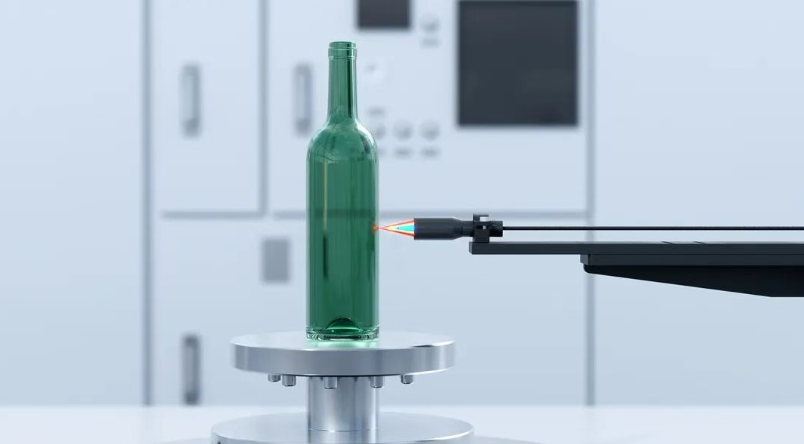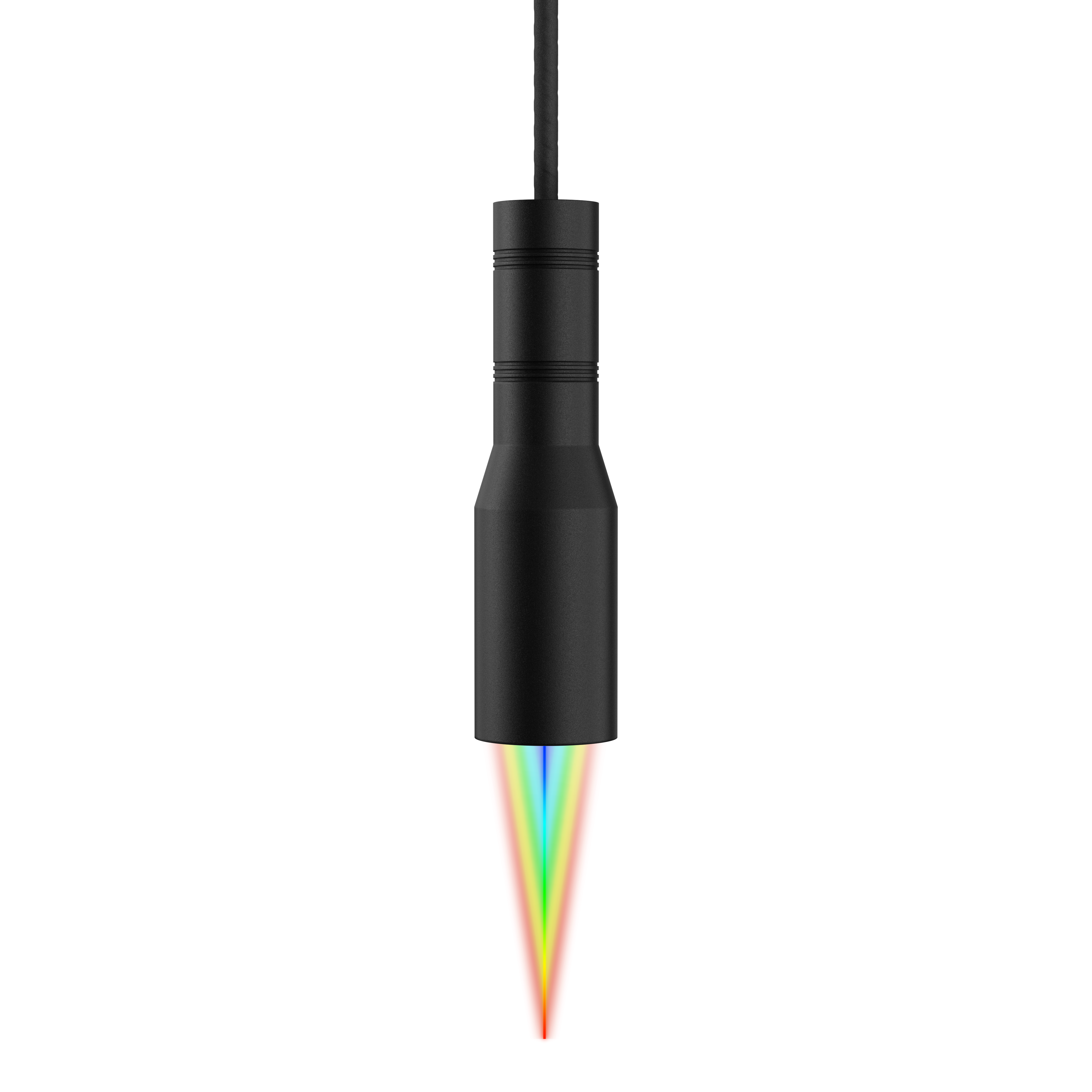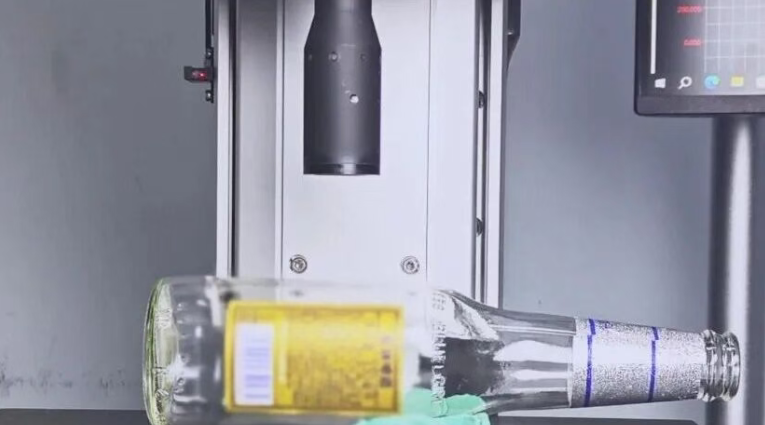Glass bottle thickness measurement has long been one of the most challenging inspection processes on global production lines. Beer bottles, in particular, are high-transparency containers with complex curved surfaces. These factors create measurement difficulties that traditional optical sensors often fail to overcome. As manufacturers worldwide strive to meet international standards and improve quality control, the demand for precise, fast, and stable glass thickness measurement has never been greater.
SinceVision’s SCI10015 Spectral Confocal Displacement Sensor provides a complete, high-performance solution that meets the requirements of modern beer bottle inspection. It delivers micron-level precision, high-speed measurement, and industrial durability.

1. Challenges in Beer Bottle Thickness Measurement
Beer bottles are made of high-transparency glass and shaped with complex curvature around the neck, body, and base. Measuring their thickness accurately requires overcoming multiple physical and environmental challenges that affect signal stability and measurement precision.
a) Optical Interference on the Surface
The transparency of glass creates a dual dilemma for conventional optical systems.
l Transmission effect: Light passes through the glass instead of reflecting from it, weakening the return signal and leading to insufficient data for accurate measurement.
l Reflection effect: Part of the light bounces off the surface irregularly, producing stray light interference. This causes unstable readings, especially when the bottle rotates or moves during inspection.
The combination of transmission and reflection interference makes it difficult for traditional sensors to capture consistent, reliable data on production lines operating at high speeds.
b) Curved Surface Adaptation
Beer bottles are not flat. Their surfaces feature continuously changing curvature, especially around the shoulder, neck, and base areas. When a conventional laser sensor encounters a curved surface, the laser spot distorts or shifts, creating inconsistent focal points. This distortion leads to inaccurate thickness readings, particularly at non-uniform sections where curvature changes sharply.
c) Industrial Environment Tolerance
Industrial production lines run continuously, often under vibration, dust, and temperature fluctuation. Traditional thickness gauges experience temperature drift, where even small environmental changes cause data deviations. In addition, vibration and dust contamination can destabilize optical paths. These factors prevent conventional sensors from performing continuous 24-hour, high-precision measurements under actual factory conditions.
d) Balance Between Precision and Speed
Beer bottle manufacturers must comply with strict quality control standards. According to GB 4544-2020 “Beer Bottles”, the measurement system must achieve:
l Resolution: 0.02 mm
l Repeatability: ≤0.01 mm
l Inspection speed: ≤1 second per bottle
Traditional optical sensors struggle to maintain this balance between precision and inspection speed, often forcing manufacturers to compromise one for the other.
2. Measurement Requirements
To achieve consistent quality inspection under real-world industrial conditions, the measurement system must meet the following criteria:
l Measurement Target: Beer bottle sidewall thickness
l Material: High-transparency glass (refractive index 1.52) with curved surface geometry
l Precision: Repeatability ≤0.01 mm
l Speed: Inspection cycle ≤1 second per bottle
These requirements reflect the balance between precision and efficiency that global manufacturers need to maintain competitive production quality and throughput.
3. SinceVision’s Spectral Confocal Displacement Sensor Solution
SinceVision developed a comprehensive measurement solution using spectral confocal technology, combining optical innovation, hardware optimization, and algorithm refinement.
Measurement Principle
The system applies the dispersive confocal direct reflection method.
a. A broadband white light source passes through a dispersive lens, forming a wavelength–distance mapping.
b. The light reflects from both the upper and lower surfaces of the glass bottle wall.
c. A confocal pinhole filters the returning light, and a spectrometer determines the peak wavelengths corresponding to each reflection.
d. The difference in wavelength peaks is used to calculate the thickness with sub-micron precision.
This non-contact, optical method eliminates the influence of mechanical pressure or surface deformation and allows accurate measurement even on transparent, curved glass.
Core Configuration
l Sensor Model: SinceVision SCI10015 Spectral Confocal Displacement Sensor
l Measurement Range: 10 mm
l Detection Capability: Transparent objects as thin as 300 μm
l Axial Resolution: 0.012 μm
This configuration allows the SCI10015 to capture micron-level variations across complex glass geometries, providing traceable, repeatable results suitable for global production standards.
Installation and Optical Path
The SCI10015 is mounted horizontally and coaxially, keeping the optical axis aligned with the bottle surface to minimize refraction-induced measurement errors. The sensor supports ±15° reflection reception, enabling it to adapt to varying surface curvatures while maintaining precise optical focus and accurate thickness data.
Scanning and Trigger System
With a 33 kHz sampling rate and an encoder-triggered scanning mechanism, the system ensures high-speed and synchronized data acquisition. The result is a 0.01 mm point spacing, meeting both the precision and speed requirements of beer bottle inspection on automated production lines.
4. Key Advantages of the SCI10015
1. Sub-Micron Precision
With an axial resolution of 0.012 μm, the SCI10015 achieves traceable, GMP-compliant measurement data. Its advanced peak-detection algorithm enables it to detect even the smallest variations in glass thickness, ensuring reliable and consistent quality control.
2. High-Speed Measurement
The 33 kHz sampling rate enables real-time measurement at production line speeds. Even as bottles move through the inspection area, the SCI10015 captures accurate data without sacrificing precision or repeatability.
3. Material Compatibility
The SCI10015’s high-sensitivity algorithm and bright broadband light source allow stable measurement across a range of materials. Whether the target is transparent, semi-transparent, or reflective, the sensor maintains high signal stability. This capability is critical for beer bottles, where both the surface reflection and transmitted light must be accurately analyzed.
4. Industrial Durability
In demanding factory environments, the SCI10015 delivers consistent performance. With temperature drift as low as 0.15 μm/°C and armored fiber cables, it withstands variable temperatures, vibration, and dust exposure. This ensures reliable operation in continuous 24-hour production cycles worldwide.
5. Recommended SinceVision Sensor
The SCI10015 spectral confocal displacement sensor is engineered for ultra-precise measurement tasks that demand both speed and accuracy.
Technical Highlights:
l Axial Resolution: 0.012 μm
l Linearity: ±1.6 μm
l Measurement Range: 10 mm
l Working Distance: 40 mm
l Spot Size: 19.2/40.3 μm
l Acceptance Angle: ±15°
l Minimum Detectable Thickness: 300 μm

These specifications allow the SCI10015 to handle minute step differences, thin films, and electrode sheet thickness variations, as well as complex geometries such as curved glass surfaces.
For multi-axis motion systems, the SCI10015 supports a 3-axis encoder, enabling synchronized measurements across multiple directions. This makes it ideal for automated inspection lines where accuracy, adaptability, and efficiency are equally critical.
6. Conclusion
SinceVision’s spectral confocal displacement sensor effectively solve the long-standing challenges of beer bottle thickness measurement, providing unmatched precision, adaptability, and stability.
The SCI10015 is not limited to beer bottles. Its optical design and algorithm make it suitable for measuring a wide range of transparent and precision materials, including:
Ø Flat and curved glass surfaces
Ø Smartphone and tablet screens
Ø Semiconductor wafers
Ø Optical films and coated layers
By combining speed, precision, and industrial endurance, SinceVision’s SCI10015 has become a trusted tool in industrial metrology and smart manufacturing worldwide.
If your production line faces similar measurement challenges, SinceVision offers custom testing and technical consultation. Contact us to request a free sample evaluation and experience the performance of the SCI10015 in real production environments.
SinceVision’s SCI10015 spectral confocal displacement sensor stands as a reliable, high-performance choice for glass bottle thickness measurement. It combines precision, speed, and global reliability for manufacturers aiming to meet the highest international standards.
-
Corporate News2025-10-22SinceVision Sponsors FLUCOME 2025 and Set to Debut Breakthrough AIR Series High-Speed Camera in The Netherlands
-
Corporate News2025-10-20SinceVision to Launch Groundbreaking AIR Series at 6th International Conference on Fluid Flow and Thermal Science (ICFFTS 2025)
-
Industry News2025-10-10Transform PCB Quality Control from Reactive to Proactive with 3D Laser Profiling
-
Industry News2025-09-30Precision in Power Electronics: SinceVision SR8060 3D Laser Profiler for IGBT Heat Dissipation Module Inspection








